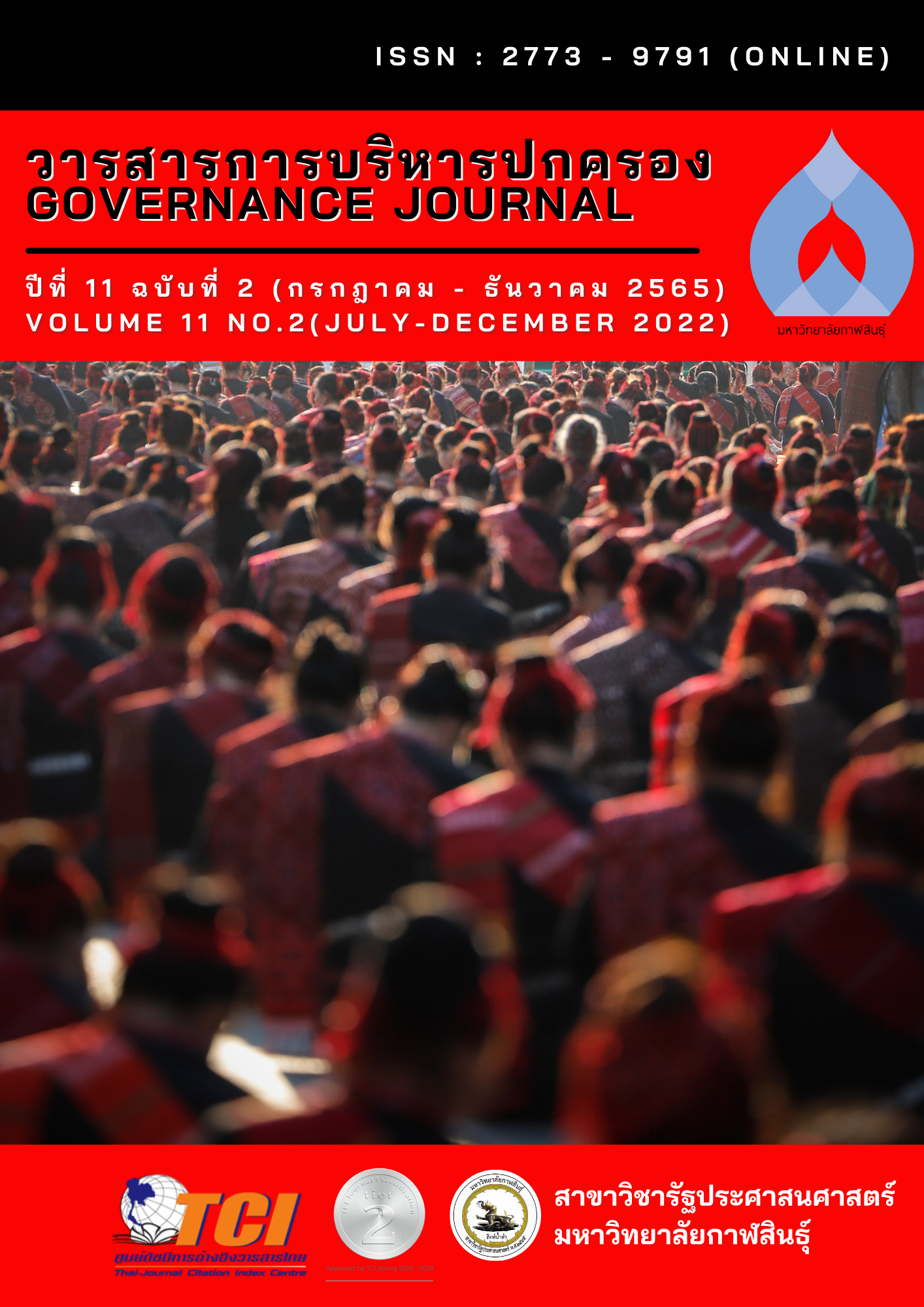บริบททางสังคมและการเปลี่ยนแปลงอัตลักษณ์ทางวัฒนธรรมของกลุ่มชาติพันธุ์ไทญ้อ บ้านแซงบาดาล ตำบลแซงบาดาล อำเภอสมเด็จ จังหวัดกาฬสินธุ์
DOI:
https://doi.org/10.14456/gjl.2022.22คำสำคัญ:
บริบททางสังคม; ชาติพันธุ์; การเปลี่ยนแปลง; การรักษาอัตลักษณ์ทางวัฒนธรรมบทคัดย่อ
การวิจัยครั้งนี้มีวัตถุประสงค์คือ 1) เพื่อศึกษาบริบททางสังคมของกลุ่มชาติพันธุ์ไทยญ้อ 2) เพื่อศึกษาการเปลี่ยนแปลงและสาเหตุการเปลี่ยนแปลงวิถีชีวิตของกลุ่มชาติพันธุ์ไทยญ้อ 3) เพื่อศึกษาแนวทางการรักษาอัตลักษณ์ทางวัฒนธรรมของกลุ่มชาติพันธุ์ไทยญ้อ ผู้ให้ข้อมูลหลักคือ ชาวไทยญ้อ ตำบลแซงบาดาล อำเภอสมเด็จ จังหวัดกาฬสินธุ์ กลุ่มตัวอย่างผู้ให้ข้อมูลสำคัญ มีอายุตั้งแต่ 50 ปีขึ้นไป จำนวน 30 คน เก็บข้อมูลโดยการสัมภาษณ์เชิงลึก นำข้อมูลที่ได้จากการสัมภาษณ์มาวิเคราะห์ โดยใช้ทฤษฎีและงานวิจัยที่เกี่ยวข้องเป็นแนวทางในการวิเคราะห์ข้อมูล ผลการวิจัยพบว่า กลุ่มชาติพันธุ์ไทยญ้อ อพยพมาจากเมืองคำม่วนเข้ามาอาศัยอยู่ในตำบลแซงบาดาล อำเภอสมเด็จ จังหวัดกาฬสินธุ์ สภาพทางด้านภูมิศาสตร์อาศัยใกล้แหล่งน้ำ เพื่อทำการเกษตรและการอุปโภคบริโภค สภาพทางด้านเศรษฐกิจประกอบอาชีพทำนาเป็นหลัก สภาพด้านสังคมและวัฒนธรรม เป็นสังคมแบ่งปัน มีความเป็นอยู่เรียบง่าย ส่วนในทางด้านวัฒนธรรมนั้น ยึดถือปฏิบัติตามฮีต 12 คอง 14 ในวิถีชีวิตมีการเปลี่ยนแปลงในด้านอาหาร ภาษา การแต่งกาย วัฒนธรรม ประเพณี วิถีชีวิต บทบาทเพศ และการสร้างบ้าน โดยมีสาเหตุมาจากโลกาภิวัฒน์และการพัฒนาประเทศ ส่งผลให้มีการปรับเปลี่ยนวิถีชีวิตแบบใหม่ ในส่วนของแนวทางการสืบทอดมีการอนุรักษ์และส่งเสริมวิถีชีวิตแบบดั้งเดิมที่เป็นหลักปฏิบัติของกลุ่มชาติพันธุ์ไทยญ้อให้คงอยู่สืบไปในสังคม
Downloads
เอกสารอ้างอิง
ครูไทยเพื่อศิษย์. 2554. ปัจจัยด้านอัตลักษณ์ทรัพยากรท่องเที่ยวที่มีผลต่อความสำเร็จในการจัดการการท่องเที่ยวหมู่บ้านช้างบ้านตากลาง จังหวัดสุรินทร์ วิทยานิพนธ์ศิลปศาสตรมหาบัณฑิต
คณะการจัดการท่องเที่ยวและการโรงแรม มหาวิทยาลัยมหาสาคาม.
ชลธิชา เจิมพันธุ์. (2552). การศึกษาศักยภาพเพื่อพัฒนาการท่องเที่ยววัฒนธรรมกลุ่ม
ชาติพันธุ์ไทย้อ (ญ้อ) บ้านโพน ตำบลโนนตาล อำเภอท่าอุเทน จังหวัด
นครพนม.มหาวิทยาลัยขอนแก่น:ขอนแก่น.
โชติกา ศรีประเสริฐ. 2554. กระบวนการออกแบบอัตลักษณ์. [ออนไลน์]. แหล่งที่มา:
http://chotika51-thesis.blogspot.com/2011/07/blog-post_31.html
นฤมล ลภะวงศ์.(2557). กระบวนการจัดการเพื่อรักษาอัตลักษณ์ทางวัฒนธรรมของกลุ่ม
ชาติพันธุ์ปกาเกอะญอ บ้านหนองมณฑา อำเภอแม่วาง จังหวัดเชียงใหม่.
วารสารวิชาการการท่องเที่ยวไทยนานาชาติ. 10(2) 44-55.
ธงชัย สมบูรณ์. (2549) อัตลักษณ์ของชาติตามนโยบายการศึกษา. คณะศึกษาศาสตร์
มหาวิทยาลัยรามคำแหง : กรุงเทพฯ.
ประสิทธิ์ ลีปรีชา. (2547). การสร้างและสืบทอดอัตลักษณ์ของกลุ่มชาติพันธุ์ม้ง.
ในวาทกรรมอัตลักษณ์. กรุงเทพฯ : ศูนย์มานุษยวิทยาสิรินธร (องค์การมหาชน).
วรเมธ ยอดนุ่ม. (2548). อัตลักษณ์ของชาติพันธุ์ในบริบทการท่องเที่ยว ศึกษากรณี
หมู่บ้านรวมมิตร อำเภอเมือง จังหวัดเชียงราย. มหาวิทยาลัยเกษตรศาสตร์
วิทยาเขตเฉลิมพระเกียรติ. จังหวัดสกลนคร.
วชิรวิทย์ ก้านจักร.(2558). วิถีชีวิตของชาวไทญ้อในเขตตำบลคลองน้ำใส อำเภออรัญ
ประเทศ จังหวัดสระแก้ว.วารสารมนุษยศาสตร์และสังคมศาสตร์ มหาวิทยาลัย
ราชพฤกษ์. 1(2) 70-80.
ศิริกมล สายสร้อย. (2540). วิถีชีวิตของชาวไทญ้อในอ้าเภออรัญประเทศ. ส้านักงาน
คณะกรรมการวัฒนธรรมแห่งชาติ. (อัดสำเนา).
สม จะเปา.(2560).การเปลี่ยนแปลงคุณภาพชีวิตของกลุ่มชาติพันธุ์คะฉี่น บ้านใหม่
สามัคคี ตำบลเมืองนะ อำเภอเชียงดาว จังหวัดเชียงใหม่.วารสารพุทธศาสตร์
ศึกษา. 8(2) 69-77.
สมิง จารย์คุณ. (2557). อัตลักษณ์ของกลุ่มชาติพันธุ์ลาวในบริบทการพัฒนา :
กรณีศึกษาชุมชน บ้านทัพคล้าย อำเภอบ้านไร่ จังหวัดอุทัยธานี.
มหาวิทยาลัยเกษตรศาสตร์.: กรุงเทพฯ.
โสภณ มูลหาและคณะ.(2565).อัตลักษณ์ชาติพันธุ์จังหวัดกาฬสินธุ์และการสร้างโอกาส
ของนวัตกรรมผลิตภัณฑ์จังหวัดกาฬสินธุ์. มหาวิทยาลัยกาฬสินธุ์. กาฬสินธุ์.
อ้อมเดือน สดมณี. (2540). จิตวิทยาสังคม.กรุงเทพฯ : สถาบันวิจัยพฤติกรรมศาสตร์
มหาวิทยาลัย ศรีนครินทรวิโรฒ ประสานมิตร.
Translated Thai References
Chanya Apipalkul, Chonthicha Jermphan. (2009) Potential studies for the development of cultural tourism Thaio ethnic group (Jho) Ban Phon, Non Tan Subdistrict, Tha Uten District, Nakhon Phanom Province. Khon Kaen University:Khon Kaen.
Chotika Sriprasert. (2011). Identity Design Process. [online]. Derivation:
http://chotika51-thesis.blogspot.com/2011/07/blog-post_31.html
Ministry of Culture. (2009). “National Culture Master Plan Source (2007-
”. [Online]. Available : http://www.m-culture.go.th/. Retrieved
August 22, 2018. [In Thai]
Narumon loppawong (2014). The process of managing to preserve the
cultural identity of the Pakagueño ethnic group. Ban Nong Mantha,
Mae Wang District, Chiang Mai Province. International Journal of Thai
Tourism.10(2) 44-55.
Omduean Sodmanee (2007). Social Psychology.Bangkok : Institute of
Behavioral Science Research, Srinakharinwirot University, Prasarnmit.
Prasit Leepreecha. (2004). Establishing and inheriting the identity of the Hmong ethnic group. In Kwan Shiwan Red Lotus (editor.).Identity discourse. Bangkok: Sirindhorn Anthropological Center.
Sirikamon Saysroy. (1997). The way of life of the Thai yho people in
Aaporean Pradesh.Board of Directors (duplication).
Sopon Mulha and et al. (2022). Ethnic identity in Kalasin province and the
opportunity creation of product innovation in Kalasin Province.
Kalasin University. Kalasin.
Som Japao. (2017). Changes in the quality of life of the Kachin ethnic group
Ban Mai Samakkhi, Mueang Na Subdistrict, Chiang Dao District, Chiang
Mai Province.Journal of Buddhist Studies. 8(2) 69-77.
Saming JanKhun. (2014). Identity of Lao ethnic groups in a development
context : a community case study Ban Thap is similar to Ban Rai
District, Uthai Thani Province. Kasetsart University.: Bangkok.
Thongchai Somboon (2006) National identity according to education policy.
Faculty of Education, Ramkhamhaeng University : Bangkok.
Thai Teachers for Disciples.(2011). Identity factors, tourist resources that
affect management success. Ban Ta Klang Elephant Village Tourism,
Surin Province Master of Arts Thesis, Faculty of Tourism and
Hospitality Management, Mahasakam University.
wachirawit kanjak.(2015). Tha Yho people's way of life in Khlong Nam Sai
Subdistrict, Aranyaprathet District, Sa Kaeo Province.Journal of
Humanities and Social Sciences, Rajaphruek University.1(2) 70-80.
Worameth Yodnoom. (2005). Ethnic identity in a tourism context Study the
case of the Villages included. Mit, Muang District, Chiang Rai Province.
Kasetsart University Campus Chalermprakiat.
ดาวน์โหลด
เผยแพร่แล้ว
รูปแบบการอ้างอิง
ฉบับ
ประเภทบทความ
สัญญาอนุญาต

อนุญาตภายใต้เงื่อนไข Creative Commons Attribution-NonCommercial-NoDerivatives 4.0 International License.








